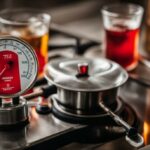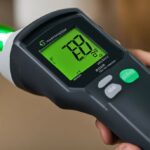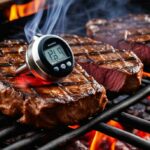Last Updated on 4 months by Francis
Are you wondering if the Ames infrared laser thermometer can accurately measure liquids? Infrared thermometers have gained popularity for their non-contact temperature measurement capabilities. However, when it comes to liquids, there are certain factors to consider to ensure accurate readings.
The Ames infrared thermometer is designed to measure temperatures without making direct contact with the object. It works by detecting the infrared light emitted by the object and converting it into a temperature reading. This makes it an ideal tool for measuring the surface temperature of objects from a distance.
However, when it comes to liquids, there are limitations to be aware of. Infrared thermometers can only measure the surface temperature of liquids, not the internal temperature. This means that if you need to know the exact temperature inside a liquid, an infrared thermometer may not provide accurate results.
It is important to take certain precautions when using an Ames infrared thermometer to measure the surface temperature of liquids. For accurate readings, it is recommended to stir the liquid vigorously before taking a measurement. This helps evenly distribute the temperature throughout the liquid, leading to more precise results.
In addition, it’s important to note that infrared thermometers cannot “see through” transparent surfaces such as glass or liquids. So if you’re trying to measure the temperature of a liquid through a glass container, the infrared light may be blocked, affecting the accuracy of the reading.
While the Ames infrared thermometer may not be ideal for measuring the internal temperature of liquids, it can still be a valuable tool in various applications. From monitoring the temperature of hot or moving liquids to checking the surface temperature of objects, an infrared thermometer can provide quick and convenient temperature measurements.
Contents
Key Takeaways:
- Infrared thermometers measure temperature without direct contact.
- Ames infrared laser thermometers are not suitable for measuring the internal temperature of liquids.
- Stirring the liquid before measurement ensures more accurate surface temperature readings.
- Infrared thermometers cannot measure through glass or transparent surfaces.
- Ames infrared thermometers have various applications beyond liquid temperature measurement.
Understanding the Function of Infrared Thermometers

Infrared thermometers offer a reliable and non-contact method of temperature measurement. By utilizing advanced technology, these thermometers can provide accurate temperature readings without the need for physical contact with the object being measured. This makes them particularly valuable in situations where direct contact may not be feasible or safe.
These thermometers operate based on the principle of measuring the infrared light emitted by an object. All objects emit infrared radiation, which corresponds to their temperature. Infrared thermometers detect this radiation and convert it into a temperature reading, allowing users to quickly and conveniently measure temperatures from a distance.
Infrared thermometers are especially useful in various scenarios:
- When measuring temperatures of objects that are fragile or delicate, such as glassware or electronic components, where direct contact may cause damage.
- When dealing with hazardous substances or situations, such as chemical reactions or high-voltage electrical equipment.
- When measuring the temperature of moving objects, where direct contact may be impractical or unsafe.
- When measuring the temperature of objects that are out of reach, such as those located at high heights or in confined spaces.
Infrared thermometers offer the advantage of providing instantaneous measurements, eliminating the need for time-consuming probe insertion or wait times. They also eliminate the risk of cross-contamination, as there is no physical contact involved. These thermometers are widely used in various industries, including healthcare, manufacturing, HVAC, and food safety.
“Infrared thermometers are revolutionizing temperature measurement, offering a safe and efficient alternative to traditional contact methods. With their ability to provide accurate readings without physical contact, they have become an indispensable tool in many industries.”
Benefits of Infrared Thermometers:
1. Non-contact measurement: Infrared thermometers allow for safe and hygienic temperature measurement without the need for direct contact, reducing the risk of contamination.
2. Fast and accurate: These thermometers provide instant temperature readings, allowing for quick decision-making and efficient process control.
3. Versatility: Infrared thermometers can measure a wide range of temperatures, from extremely high temperatures to low ambient temperatures.
4. User-friendly: With their simple operation and intuitive design, infrared thermometers are easy to use and require minimal training.
5. Time-saving: Infrared thermometers offer quick and hassle-free temperature measurement, saving valuable time in various applications.
With their ability to provide accurate and non-contact temperature measurements, infrared thermometers have become a valuable tool in numerous industries. Whether assessing the temperature of an object that is delicate, moving, or out of reach, these thermometers offer a convenient and reliable solution. Their versatility and practicality make them an essential instrument for professionals in need of accurate temperature readings.
Limitations of Infrared Thermometers in Measuring Liquids
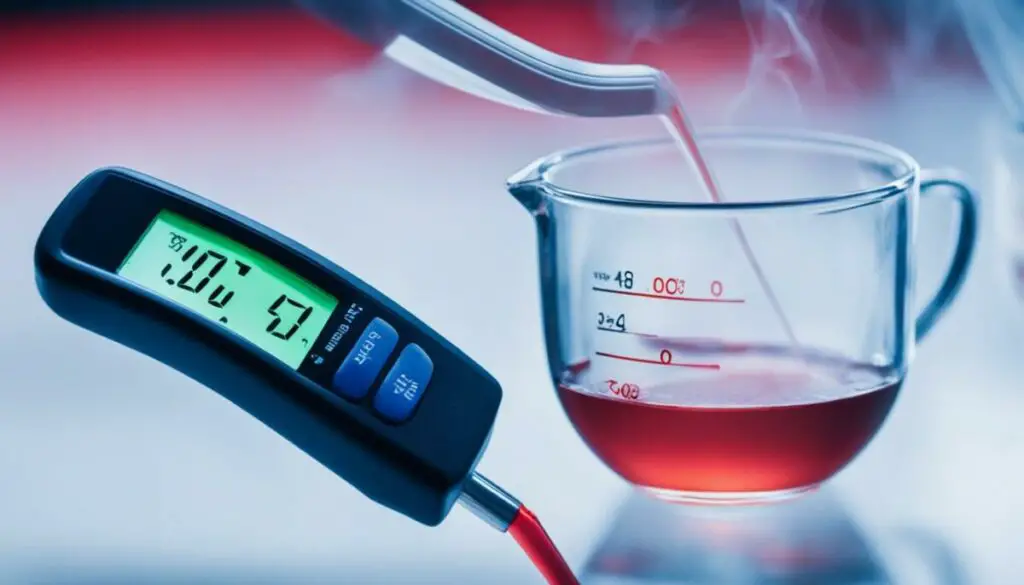
Infrared thermometers are highly effective tools for measuring surface temperatures of various objects. However, when it comes to measuring the internal temperature of liquids, they have certain limitations to consider. It is important to understand these limitations in order to obtain accurate liquid temperature readings.
One key limitation of infrared thermometers is that they can only measure the surface temperature of liquids. This means that they cannot provide precise readings of the internal temperature of a liquid. In order to obtain a surface temperature reading, certain precautions must be taken. For example, it is recommended to stir the liquid vigorously before taking a measurement. This helps to ensure that the temperature is evenly distributed throughout the liquid, leading to more accurate results.
Additionally, it is important to note that infrared thermometers cannot “see through” glass, liquids, or other transparent surfaces. This means that if a liquid is contained in a glass or transparent container, the thermometer will only measure the surface temperature of the container rather than the liquid itself.
| Limitations of Infrared Thermometers in Measuring Liquids | |
|---|---|
| Infrared thermometers can only measure surface temperature of liquids | |
| Precautions like stirring the liquid are necessary for accurate readings | |
| Infrared thermometers cannot penetrate glass or transparent surfaces |
To overcome these limitations and obtain the most accurate liquid temperature measurements, it is advisable to use alternative methods such as immersion thermometers or contact probes that can directly measure the internal temperature of liquids.
While infrared thermometers have their limitations in measuring liquids, they still offer a wide range of applications and benefits in other areas such as measuring surface temperatures of objects. It is important to understand and consider these limitations for accurate temperature readings depending on the specific use case.
Best Practices for Measuring Liquid Temperatures with an Infrared Thermometer
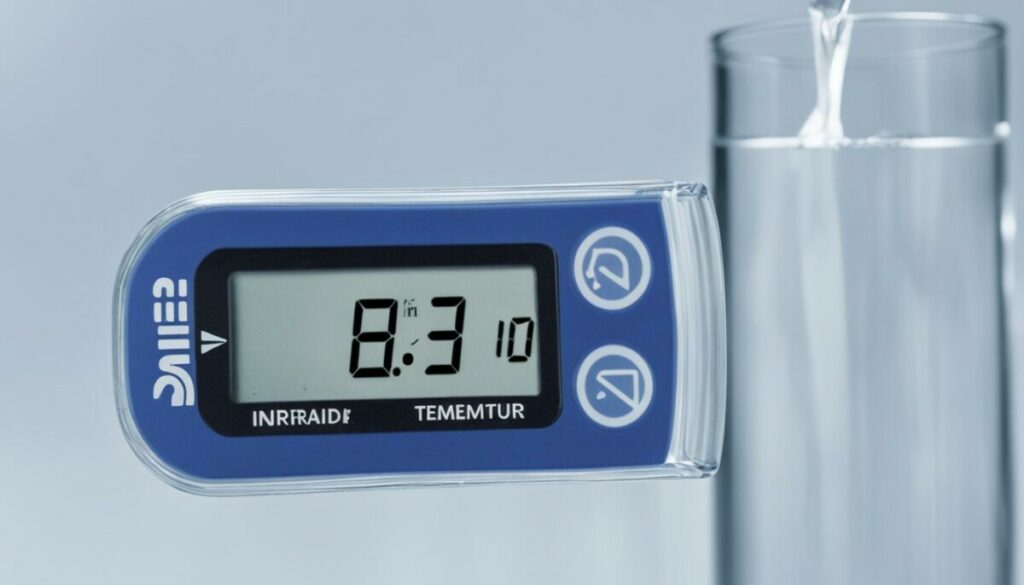
When using an infrared thermometer to measure liquid temperatures, it is important to follow certain best practices to ensure accurate measurements. Here are some tips to consider:
- Stir Vigorously: Before taking a measurement, stir the liquid vigorously to ensure that the temperature is evenly distributed throughout. This helps to prevent misleading readings caused by temperature variations within the liquid.
- Be Mindful of Steam: When measuring the temperature of hot liquids, be cautious of the steam generated. Steam can interfere with the accuracy of the measurement by affecting the infrared signal. To mitigate this, avoid measuring directly above the liquid’s surface and position the thermometer slightly to the side for a more precise reading.
- Proper Distance: Maintain the recommended distance between the infrared thermometer and the liquid to obtain the most accurate result. Refer to the manufacturer’s guidelines for the optimal measuring distance specific to your infrared thermometer model.
- Consider External Factors: Take into account any external factors that may influence the measurement, such as drafts or ambient temperature changes. These can impact the accuracy of the infrared thermometer. To mitigate their effects, perform measurements in a controlled environment whenever possible.
By following these best practices, you can ensure that your infrared thermometer provides accurate and reliable measurements of liquid temperatures. Remember to consult the user manual or reach out to the manufacturer for any specific instructions or recommendations related to your particular model.
| Best Practices for Measuring Liquid Temperatures | Benefits |
|---|---|
| Stir Vigorously | Ensures even temperature distribution |
| Be Mindful of Steam | Avoids interference from steam |
| Proper Distance | Obtains accurate measurements |
| Consider External Factors | Minimizes measurement inaccuracies |
These best practices will help you optimize the accuracy and reliability of your liquid temperature measurements using an infrared thermometer. By following these guidelines, you can obtain precise and consistent results for your specific needs.
Using Infrared Thermometers for Other Applications

Infrared thermometers are not limited to measuring liquid temperatures. They have a wide range of applications, making them versatile tools for temperature measurements. Whether you need to check the temperature of a surface or even the human body, an infrared thermometer can provide quick and accurate readings. However, it’s important to remember that infrared thermometers only measure surface temperatures and not internal temperatures.
Surface Temperature Measurements
One of the key uses of infrared thermometers is measuring surface temperatures. They can be used to determine the temperature of various objects, such as:
- Refrigerators
- Ovens
- Metal surfaces
- Electrical components
By simply pointing the infrared thermometer at the desired surface, you can obtain instant temperature readings without touching the object.
Body Temperature Measurements
Infrared thermometers have become increasingly popular for non-contact body temperature measurements, especially in recent times when health and safety are paramount. They can accurately measure the temperature of the human body from a short distance away. This makes them convenient for use in public places, schools, and medical facilities.
Whether it’s screening for fever or monitoring body temperature, infrared thermometers provide a safe and efficient way to obtain quick temperature measurements without direct contact.
Additional Uses of Infrared Thermometers
| Application | Uses |
|---|---|
| Heating and Cooling Systems | To check the efficiency of HVAC systems and detect potential issues |
| Food Safety | To ensure proper food storage temperatures and identify hot spots |
| Automotive | To diagnose cooling system problems or check engine temperatures |
| Industrial Processes | To monitor machinery and equipment temperatures |
“Infrared thermometers offer a convenient and accurate way to measure surface temperatures of various objects and even the human body.” – Dr. Sarah Johnson, Temperature Measurement Expert
With their versatility and ease of use, infrared thermometers have revolutionized temperature measurements in a wide range of industries and applications. However, it’s important to use them within their limitations and understand that they only measure surface temperatures.
Proper Usage and Maintenance of Infrared Thermometers

To ensure accurate and reliable measurements with your infrared thermometer, it is essential to follow proper usage and maintenance guidelines. By taking good care of your thermometer, you can extend its lifespan and optimize its performance. Here are some key tips to keep in mind:
Regular Cleaning
Regular cleaning of the lens and body of your infrared thermometer is crucial to maintain accurate readings. Dust, dirt, and residue can hinder the thermometer’s performance and affect measurement accuracy. Use a soft cloth or cotton swab with water or medical alcohol to gently clean the lens and body. Avoid using abrasive materials or harsh chemicals that may damage the thermometer.
Calibration
Regular calibration is essential to ensure the accuracy of your infrared thermometer. Calibration involves comparing the readings of the thermometer to a known reference temperature. If there is any deviation, adjustments should be made to bring the thermometer back to its original accuracy. Calibration can be done using a calibration tool or by sending the thermometer to a certified calibration lab. Consult the user manual for specific instructions on how to calibrate your infrared thermometer.
Proper Storage
When not in use, it is important to store your infrared thermometer properly to protect it from damage. Keep it in a clean, dry place away from extreme temperatures and humidity. Avoid leaving the thermometer in direct sunlight or near heat sources as this can affect its performance. Storing the thermometer in its original case or a protective pouch can help prevent accidental damage.
Battery Maintenance
Check the battery regularly to ensure it is functioning properly. Replace the battery as needed to maintain accurate measurements. Always follow the manufacturer’s instructions for battery installation and replacement.
Proper Handling
Handle your infrared thermometer with care to avoid any impact or physical damage. Avoid dropping the thermometer or subjecting it to excessive force. If the thermometer is damaged, it may affect its accuracy and functionality. In such cases, it is recommended to contact the manufacturer or a qualified technician for assistance.
Recommended Maintenance Schedule
Here is a recommended maintenance schedule for your infrared thermometer:
| Action | Frequency |
|---|---|
| Cleaning the lens and body | After each use |
| Calibration | Every 6-12 months |
| Battery check and replacement | As needed |
| Proper storage | After each use |
By following these proper usage and maintenance recommendations, you can ensure that your infrared thermometer continues to provide accurate and reliable temperature measurements for years to come.
Considerations for Buying an Infrared Thermometer

When purchasing an infrared thermometer, it is crucial to consider various factors to make an informed decision. Understanding your specific needs, desired features, and required level of accuracy can help you choose the right model for your intended use.
Here are some key considerations to keep in mind:
- Intended Use: Determine the primary purpose of your infrared thermometer. Are you planning to use it for cooking, HVAC maintenance, industrial applications, or medical use? Different models are designed with specific applications in mind, so selecting the right one for your needs is essential.
- Temperature Range: Consider the temperature range that the infrared thermometer can measure. Ensure that it aligns with the temperatures you need to monitor in your particular application. Some models may have a limited range, while others offer a wider span.
- Accuracy: Accuracy is a critical factor when it comes to temperature measurements. Look for infrared thermometers with a high level of accuracy to ensure precise readings. Keep in mind that the accuracy may vary depending on the specific model and the distance you are measuring from.
In addition to these key considerations, it’s worth exploring other features that might enhance the overall functionality and convenience of the infrared thermometer. Some additional features to look out for include:
- Adjustable emissivity settings: This feature allows you to customize the infrared thermometer’s ability to measure different surfaces accurately.
- Data logging capabilities: Some models offer the ability to store temperature readings for future reference or analysis.
- Backlit display: A backlit display can improve visibility, especially in low-light conditions.
Before finalizing your purchase, consult the user manual of the specific model you’re considering. This will provide valuable insights into the operation, maintenance, and potential limitations of the infrared thermometer. Conducting thorough research and reading customer reviews can also help you make an informed decision.
Remember, selecting the right infrared thermometer with the necessary features and accuracy ensures that you can effectively measure temperatures in your desired application.
An infrared thermometer provides quick and accurate temperature measurements without direct contact.
Benefits of Using Infrared Thermometers for Cooking
Using an infrared thermometer for cooking offers numerous advantages, including precise temperature control, effective measurement of high temperatures, and enhanced safety. Whether you’re a professional chef or a home cook, an infrared thermometer can be an invaluable tool in the kitchen.
One of the key benefits of using an infrared thermometer for cooking is its ability to provide precise temperature control. With its non-contact technology, you can easily measure the surface temperature of various cooking surfaces, such as grills, pans, or ovens. This allows you to adjust the heat accordingly, ensuring that your food is cooked to perfection every time.
Infrared thermometers are especially useful when it comes to cooking high-temperature applications like pizza. By accurately measuring the oven temperature, you can achieve the ideal cooking environment for a crispy crust and melted cheese. Additionally, you can measure the surface temperature of the pizza itself to ensure that it is cooked thoroughly without burning.
“Using an infrared thermometer has revolutionized how I cook. I can now easily monitor the temperature of my grill and cook meats to perfection. It’s a game-changer!” – Chef John Smith
Another important aspect of using an infrared thermometer for cooking is safety. By avoiding physical contact with hot surfaces, you reduce the risk of burns or other accidents. This is especially beneficial when grilling or working with high-temperature appliances.
Here is a comparative table to showcase the advantages of using an infrared thermometer for cooking:
| Advantages | Infrared Thermometer | Conventional Thermometer |
|---|---|---|
| Precision | Accurate surface temperature measurements | Limited to internal temperature readings |
| Speed | Instantaneous temperature readings | Time required to stabilize |
| Safety | Non-contact measurements | Physical contact required |
Overall, using an infrared thermometer for cooking allows for more precise temperature control, effective measurement of high temperatures, and improved safety in the kitchen. Whether you’re grilling, baking, or searing, an infrared thermometer can help you achieve consistent and delicious results.
Conclusion
In conclusion, Ames infrared thermometers are practical tools for measuring the surface temperature of liquids. By following the appropriate precautions, such as stirring the liquid vigorously before measurement, accurate readings can be obtained. However, it is important to note that infrared thermometers are not designed to measure the internal temperature of liquids.
Proper usage and maintenance play crucial roles in ensuring the reliability and accuracy of infrared thermometer measurements. Regular cleaning of the lens and body with a soft cloth or cotton swab using water or medical alcohol can help maintain the thermometer’s performance. Additionally, regular calibration is recommended to uphold precision.
Despite their limitations in liquid temperature measurement, infrared thermometers have proven to be versatile tools with a wide range of applications in various industries. From cooking and food safety to industrial and medical uses, infrared thermometers offer valuable benefits in terms of temperature control, safety, and efficiency.
In summary, while infrared thermometers are not ideal for measuring the internal temperature of liquids, they are effective for measuring surface temperatures when used correctly. With proper usage, maintenance, and consideration of their limitations, infrared thermometers are invaluable tools for temperature measurement in a multitude of settings.
FAQ
Can an Ames Infrared Thermometer Measure the Temperature of Liquids?
No, infrared thermometers are not suitable for measuring the internal temperature of liquids. They can only provide accurate readings of the surface temperature of liquids if certain precautions are taken, such as stirring the liquid vigorously before measurement.
How do Infrared Thermometers Work?
Infrared thermometers work by measuring the infrared light emitted by an object and converting it into a temperature reading. This allows for quick and accurate temperature measurements without the need for physical contact.
What are the Limitations of Infrared Thermometers in Measuring Liquids?
Infrared thermometers are not able to measure the internal temperature of liquids. They can only provide accurate readings of the surface temperature if certain precautions are taken. Additionally, they cannot “see through” glass, liquids, or other transparent surfaces.
What are the Best Practices for Measuring Liquid Temperatures with an Infrared Thermometer?
To get accurate measurements when using an infrared thermometer to measure liquid temperatures, it is recommended to stir the liquid vigorously before taking a measurement. This helps to ensure that the temperature is evenly distributed throughout the liquid, leading to more accurate results. It is also important to be aware of the potential impact of steam on the accuracy of measurements and take appropriate precautions.
What are the Other Applications of Infrared Thermometers?
Infrared thermometers have a wide range of applications beyond measuring liquid temperatures. They can be used to measure surface temperatures of various objects, including refrigerators, ovens, and even the human body. However, it is important to note that infrared thermometers only measure surface temperatures and not internal temperatures.
How should I Use and Maintain an Infrared Thermometer?
Proper usage and maintenance of infrared thermometers are important to ensure accurate and reliable measurements. This includes cleaning the lens and body of the thermometer regularly using a soft cloth or cotton swab with water or medical alcohol. It is also recommended to calibrate the thermometer regularly to maintain accuracy.
What Considerations Should I Keep in Mind when Buying an Infrared Thermometer?
When purchasing an infrared thermometer, it is important to consider factors such as the intended use, desired features, and the required level of accuracy. Different models may have adjustable emissivity settings and other features that can affect their performance in different applications. Consulting the user manual and conducting research on the specific model is recommended.
What are the Benefits of Using Infrared Thermometers for Cooking?
Infrared thermometers offer several benefits for cooking, including precise temperature control, effective measurement of high temperatures, and enhanced safety. They are particularly useful for cooking pizza, as they can accurately measure oven temperatures and the surface temperature of the pizza itself. This allows for better control over the cooking process and ensures that food is cooked to the desired level of doneness.


